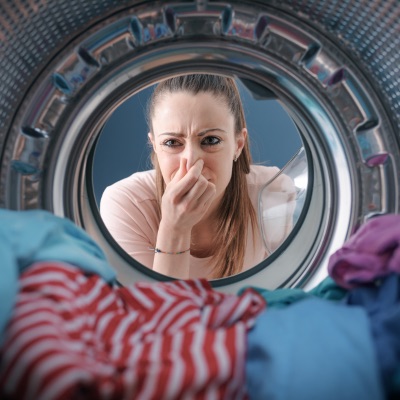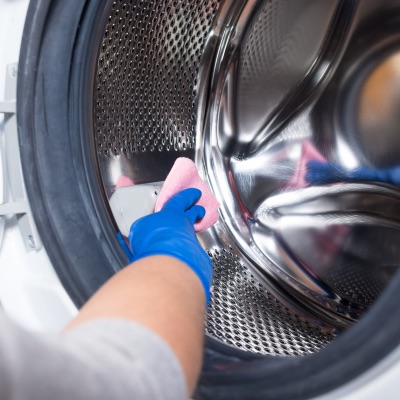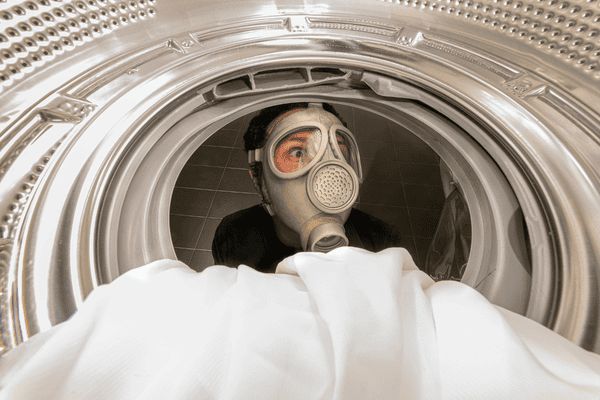There’s nothing quite as frustrating as opening your washing machine door to be greeted by an unpleasant, musty smell. Washing machines are meant to keep our clothes fresh, but over time, they can develop their own “off” odor—often due to mold and mildew that thrive in damp, enclosed spaces. At Howard Environmental, we specialize in understanding and solving mold issues in homes, including those that take root in appliances. In this guide, we’ll explain why washing machine smells occur, what causes your washer to stink, and most importantly, how to get rid of musty smells in your washer and prevent them from coming back.
Why My Washing Machine Smells

Your washing machine provides the perfect environment for mold and mildew to grow—moisture, warmth, and darkness. When you add detergent, fabric softeners, and residues from dirty clothes, you’re giving mold exactly what it needs to thrive. If your washing machine stinks, it’s likely due to these key factors:
- Moisture Buildup: After each cycle, residual water remains inside the machine. If it doesn’t fully dry out, that moisture can foster mold and mildew growth, leading to that unpleasant odor.
- Detergent and Fabric Softener Residues: Detergents and fabric softeners often leave behind residues, especially in high-efficiency washers that use less water. These residues trap bacteria and mold, which can cause your washing machine to smell.
- Dirty Gaskets and Seals: Front-loading washers, in particular, have rubber gaskets and door seals that trap water and grime. Mold loves these spots, and the result is often a musty, moldy washer smell.
- Leaving Wet Clothes Inside: Forgetting to remove wet clothes promptly creates a breeding ground for bacteria and mold, adding to that musty, unpleasant smell.
Now that you understand the causes of washing machine smells, let’s dive into the steps you can take to clean and deodorize your machine.
How to Get Rid of Musty Smell in Washer

Step 1: Deep Clean the Washing Machine Drum
The drum is where clothes and water mix, and it’s also a place where mold spores and bacteria can linger. Here’s how to give it a thorough cleaning:
- Run a Hot Water Cycle: Start with an empty, high-temperature wash cycle. Hot water helps to kill mold and bacteria, giving your machine a fresh start.
- Add a Cleaning Agent: Use a cup of white vinegar or baking soda in the drum. Vinegar is a natural mold and odor eliminator, while baking soda helps to neutralize odors.
- Run an Extra Rinse Cycle: After the cleaning cycle, run an extra rinse to ensure any remaining residue is fully removed.
Expert Tip: Avoid using bleach with vinegar, as the combination can produce harmful fumes. Stick with one cleaning agent for safety.
Step 2: Clean the Detergent Dispenser and Fabric Softener Compartment
Residue from detergents and fabric softeners builds up quickly in these compartments, trapping moisture and bacteria.
- Remove and Soak: If possible, remove the detergent tray and soak it in warm, soapy water. Scrub off any residue with an old toothbrush or small cleaning brush.
- Use Vinegar for Stubborn Grime: For built-up soap scum, use white vinegar to help dissolve stubborn deposits.
- Dry Thoroughly: Once clean, let the detergent tray air-dry before reinserting it. This reduces the chance of moisture accumulating.
Step 3: Clean the Door Seal or Gasket
The door seal (or gasket) in front-loading washers is a common culprit when it comes to washing machine smells. This area traps water, detergent, and fabric softener, creating the perfect place for mold growth.
- Inspect and Wipe: Pull back the rubber seal to inspect for mold or grime. Wipe the area with a clean, damp cloth.
- Use Vinegar or Hydrogen Peroxide: Dampen a cloth with white vinegar or hydrogen peroxide and wipe down the gasket. Both are effective for killing mold spores.
- Scrub if Needed: For stubborn mold, use an old toothbrush to scrub the seal gently. Be thorough, as mold loves to hide in the folds of the gasket.
- Dry the Seal: Once clean, dry the seal with a towel to reduce future moisture buildup.
Step 4: Clean the Filter
Many washing machines have a filter that catches lint, hair, and other debris. When clogged, it can hold onto moisture and contribute to a moldy washer smell.
- Locate and Remove the Filter: Check your machine’s manual for instructions on locating and removing the filter.
- Rinse the Filter: Rinse the filter under warm running water and scrub away any grime or lint with a brush.
- Reinstall the Filter: Once clean, replace the filter and ensure it’s secure.
Preventing Moldy Smells in Your Washer

Cleaning your washer is an essential first step, but prevention will keep those washing machine smells from returning. Here are some tips for maintaining a fresh, odor-free machine:
1. Leave the Door Open
After each wash, leave the door of your machine open to allow air circulation and let any remaining moisture evaporate. This simple step can make a big difference in preventing mold from forming.
2. Use High-Efficiency (HE) Detergent
If you have a high-efficiency washer, use HE detergent to reduce residue buildup. Standard detergents create too many suds, which leave behind more residue that can trap odors.
3. Clean the Machine Monthly
A monthly cleaning routine will help keep your washing machine fresh. Run a hot water cycle with a cup of vinegar or a commercial washing machine cleaner to maintain cleanliness.
4. Remove Wet Clothes Promptly
Leaving wet clothes in the machine—even for a short period—can lead to bacterial growth and smells. Make it a habit to transfer your laundry to the dryer as soon as possible.
5. Avoid Fabric Softeners
Fabric softeners can create residue in your machine, contributing to odors. Instead, use dryer sheets or add vinegar to the rinse cycle, which softens fabrics without leaving buildup.
DIY Natural Cleaners for a Fresh-Smelling Washer
If you prefer natural cleaners, here are a few options that are effective for tackling washing machine smells:
- Vinegar and Baking Soda: Run an empty cycle with one cup of vinegar and ½ cup of baking soda to help deodorize and clean.
- Lemon Juice: For a fresh scent, add a cup of lemon juice to the drum and run a hot cycle. Lemon juice also has antibacterial properties.
- Essential Oils: Add a few drops of tea tree or lavender essential oil to your vinegar for added mold-fighting and odor-freshening power.
When to Call a Professional
If your washing machine smells persist even after thorough cleaning, there may be a more significant issue, such as mold inside the machine’s internal components. Since mold can cause health issues—especially for those with mold allergies—it’s best to call a professional to assess and deep clean the machine. (Learn more about mold allergies from the Mayo Clinic.)
At Howard Environmental, we specialize in tackling mold in hard-to-reach areas and can help ensure your appliance is thoroughly cleaned and free from odor-causing mold. Contact us if you need assistance with persistent washing machine smells or have concerns about mold in other parts of your home.
Say Goodbye to Washing Machine Smells for Good!
A moldy washer doesn’t have to be a permanent problem. By following these steps, you can eliminate washing machine smells and keep your appliance fresh and clean. Regular cleaning and maintenance, along with a few preventative measures, will help keep mold and mildew from taking root.
Remember, if your washing machine stinks even after cleaning, it may be time to consult with a professional to get to the root of the issue. Contact Howard Environmental today for expert advice and solutions for a fresh, odor-free home.

